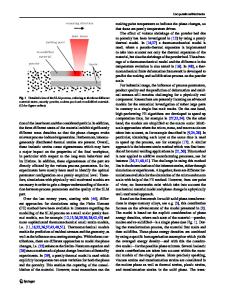Design of Wear-Resistant Austenitic Steels for Selective Laser Melting
- PDF / 3,554,854 Bytes
- 10 Pages / 593.972 x 792 pts Page_size
- 71 Downloads / 326 Views
INTRODUCTION
AUSTENITIC stainless steels are widely used in applications where a performance combining strength, toughness, and corrosion resistance is required.[1] Wear resistance, on the contrary, is considered as a potentially critical issue for austenitic steels owing to their soft single-phase face-centred cubic crystal structure. There are several ways to increase the wear resistance of austenitic steels, including solid solution hardening (mainly by Mn and N), cold plastic deformation and stress-induced transformation of austenite into martensite.[2–4] A further approach consists in second-phase hardening, by additions of carbide/boride-forming elements.[5] In the literature, information on potential improvement achievable in both austenitic and ferritic stainless steels by addition of V,[6] Ti and Nb[7] and B[8,9] is already available. Several applications of these materials would benefit from advanced wear performance such as in the processing industry and in the tool and die sectors. In these fields, additive manufacturing (AM) production techniques, allowing the generation of complex 3D shapes, are of particular interest (e.g., for the implementation of conformal cooling channels in tools).
J.N. LEMKE, R. CASATI, N. LECIS, and M. VEDANI are with the Dipartimento di Meccanica, Politecnico di Milano, Via Giuseppe La Masa 1, 20156, Milan, Italy. Contact e-mail: [email protected] C. ANDRIANOPOLI is with the Cogne Acciai Speciali SpA, Via Paravera 16, 11100, Aosta, Italy. A. VARONE and R. MONTANARI are with the Dipartimento di Ingegneria industriale, Universita` degli Studi di Roma Tor Vergata, Via del Politecnico 1, 00133, Rome, Italy. Manuscript submitted July 26, 2017.
METALLURGICAL AND MATERIALS TRANSACTIONS A
Selective Laser Melting (SLM) is the main reference technology for AM, allowing the production of parts by an additive process, where a metallic alloy powder is deposited layer-wise and selectively melted by a laser source based on a CAD file.[10–12] The processing of 316L austenitic stainless steel by SLM has already been investigated in a large number of papers. Near full-density parts could be readily produced with the absence of flaws and showing attractive mechanical properties that can reach or even exceed those of wrought counterparts.[13–16] Recent papers also focused on the modification of chemical composition of standard steel grades to improve properties and to achieve enhanced processability by SLM.[11,17] However, the number of studies on additively manufactured high-strength and tool steels containing significant amounts of carbon is still low and often it is stated that attempts to produce crack-free parts have been unsuccessful. Recent studies on steels processed by SLM and featuring a significant hardness obtained by carbide precipitation were focussed on X110CrMoVAl 8-2 alloy,[18] on Fe-Cr-Mo-V-C alloy,[19] on X40CrMoV5-1 (type H13) tool steel[20] and even ultra-high carbon (2,1 wt pct) steel.[21] The experiments showed promising results even if those steels are considered as cr
Data Loading...











